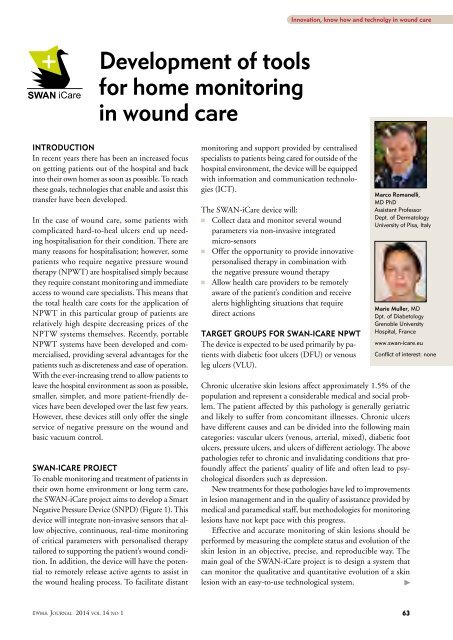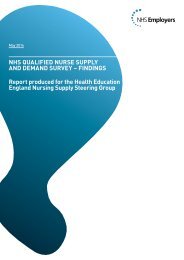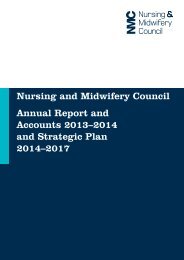Journal_1_2014_final_WEB
Journal_1_2014_final_WEB
Journal_1_2014_final_WEB
You also want an ePaper? Increase the reach of your titles
YUMPU automatically turns print PDFs into web optimized ePapers that Google loves.
Innovation, know how and technolgy in wound care<br />
Development of tools<br />
for home monitoring<br />
in wound care<br />
Introduction<br />
In recent years there has been an increased focus<br />
on getting patients out of the hospital and back<br />
into their own homes as soon as possible. To reach<br />
these goals, technologies that enable and assist this<br />
transfer have been developed.<br />
In the case of wound care, some patients with<br />
complicated hard-to-heal ulcers end up needing<br />
hospitalisation for their condition. There are<br />
many reasons for hospitalisation; however, some<br />
patients who require negative pressure wound<br />
therapy (NPWT) are hospitalised simply because<br />
they require constant monitoring and immediate<br />
access to wound care specialists. This means that<br />
the total health care costs for the application of<br />
NPWT in this particular group of patients are<br />
relatively high despite decreasing prices of the<br />
NPTW systems themselves. Recently, portable<br />
NPWT systems have been developed and commercialised,<br />
providing several advantages for the<br />
patients such as discreteness and ease of operation.<br />
With the ever-increasing trend to allow patients to<br />
leave the hospital environment as soon as possible,<br />
smaller, simpler, and more patient-friendly devices<br />
have been developed over the last few years.<br />
However, these devices still only offer the single<br />
service of negative pressure on the wound and<br />
basic vacuum control.<br />
SWAN-iCare project<br />
To enable monitoring and treatment of patients in<br />
their own home environment or long term care,<br />
the SWAN-iCare project aims to develop a Smart<br />
Negative Pressure Device (SNPD) (Figure 1). This<br />
device will integrate non-invasive sensors that allow<br />
objective, continuous, real-time monitoring<br />
of critical parameters with personalised therapy<br />
tailored to supporting the patient’s wound condition.<br />
In addition, the device will have the potential<br />
to remotely release active agents to assist in<br />
the wound healing process. To facilitate distant<br />
monitoring and support provided by centralised<br />
specialists to patients being cared for outside of the<br />
hospital environment, the device will be equipped<br />
with information and communication technologies<br />
(ICT).<br />
The SWAN-iCare device will:<br />
n Collect data and monitor several wound<br />
parameters via non-invasive integrated<br />
micro-sensors<br />
n Offer the opportunity to provide innovative<br />
personalised therapy in combination with<br />
the negative pressure wound therapy<br />
n Allow health care providers to be remotely<br />
aware of the patient’s condition and receive<br />
alerts highlighting situations that require<br />
direct actions<br />
Target Groups for SWAN-iCare NPWT<br />
The device is expected to be used primarily by patients<br />
with diabetic foot ulcers (DFU) or venous<br />
leg ulcers (VLU).<br />
Marco Romanelli,<br />
MD PhD<br />
Assistant Professor<br />
Dept. of Dermatology<br />
University of Pisa, Italy<br />
Marie Muller, MD<br />
Dpt. of Diabetology<br />
Grenoble University<br />
Hospital, France<br />
www.swan-icare.eu<br />
Conflict of interest: none<br />
Chronic ulcerative skin lesions affect approximately 1.5% of the<br />
population and represent a considerable medical and social problem.<br />
The patient affected by this pathology is generally geriatric<br />
and likely to suffer from concomitant illnesses. Chronic ulcers<br />
have different causes and can be divided into the following main<br />
categories: vascular ulcers (venous, arterial, mixed), diabetic foot<br />
ulcers, pressure ulcers, and ulcers of different aetiology. The above<br />
pathologies refer to chronic and invalidating conditions that profoundly<br />
affect the patients’ quality of life and often lead to psychological<br />
disorders such as depression.<br />
New treatments for these pathologies have led to improvements<br />
in lesion management and in the quality of assistance provided by<br />
medical and paramedical staff, but methodologies for monitoring<br />
lesions have not kept pace with this progress.<br />
Effective and accurate monitoring of skin lesions should be<br />
performed by measuring the complete status and evolution of the<br />
skin lesion in an objective, precise, and reproducible way. The<br />
main goal of the SWAN-iCare project is to design a system that<br />
can monitor the qualitative and quantitative evolution of a skin<br />
lesion with an easy-to-use technological system.<br />
<br />
EWMA <strong>Journal</strong> <strong>2014</strong> vol 14 no 1 63




